|
The pedestrian plodding wearily along the highway,
after a lengthened and devious walk, when some gay equipage dashes rapidly
past, spattering the mud around, or leaving a blinding cloud of dust along
its track, is apt to feel a passing twinge of envy, and to fancy that
their lot must indeed be a happy one who possess so handsome and luxurious
a conveyance. He is ready under such circumstances to exclaim, "How much
is their mode of progression as a means of enjoyment superior to mine!"
Yet there cannot be a greater mistake. For speedy transmission from point
to point on matters of business, or for the salutary airing of an invalid,
the various equestrian methods of transport may be all very well; but for
healthy exercise of the person, and the thorough enjoyment of nature,
there is nothing that can for a moment bear comparison with natural
locomotion. The man who travels by carriage must keep by the highway; he
cannot plunge into the recesses of the wood in search of the wilding
flower; the din of the wheels on which he is borne along drowns the sweet
voices of the birds. He cannot follow the windings & the footpath through
the whispering corn-field, nor trace that fairest line of beauty, the
"trotting burn’s meander," which, according to the bard of Coila, forms
the favourite haunt of the Parnassian sisters. Then he is continually
liable to interruption from the outstretched hand of the toll-keeper; his
horses are always getting rid of their shoes at out-of-the-way places,
where farriery is an art unknown, or his driver, taking a cup too much, is
sure to run over and squelch some unlucky urchin making mud-pies on
the middle of the road, or to come tilt
against a mile-stone and spill his unfortunate master, who, if he escapes
with nothing worse than a dislocated shoulder or a fractured collar-bone,
may thank his stars, and consider himself an exceedingly lucky fellow.
Really, amidst all our troubles— and we suppose everybody has his share—we
have much reason for gratitude to Fortune, that she has not inflicted on
us a carriage and its cares; and that without encumbrance, save our gray
hazel switch, we
"Can wander away over hill and glen,
Far as we may for the
gentlemen."
There are several ways
which the pedestrian may take at pleasure in his rambles from Glasgow to
Cathcart. Our favourite route is by Rutherglen. Connecting this burgh and
Carthcart, there is a delightful footpath, about a mile and a-half in
length, through the intervening fields. It is one of those old kirk-roads
which, having been in popular use from time immemorial, will, it is hoped,
be long preserved from the encroachments of unscrupulous proprietors, who,
in so many instances, have of late enclosed and obliterated these "old
brown lines of rural liberty." Leaving the west end of Rutherglen by this
road, we proceed towards Cathcart in a south-westerly direction. About a
quarter of a mile out of the town we pass the cottage of "Bauldie Baird,"
a plain one-storeyed edifice, which—with its proprietor, a plain blunt
man—has attained considerable local celebrity. Honest Bauldie, who is the
subject of a certain wicked song, for many years earned a decent
livelihood by the sale of "curds and cream," "fruits in their season," and
a wee drap of the mountain dew. His edibles and liqueurs, though of a
homely description, were always excellent in quality; and the place became
a favourite resort of the lads and lasses of Glasgow, who, after the toils
of the week, might have been seen
during the summer and autumn months, in laughing groups in the garden,
enjoying the good cheer which the place afforded. Bauldie had virtuous
neighbours, however, who were determined that there should "be no more
cakes and ale." Complaints were made by these parties that the stringency
of Sabbath rule was occasionally violated on his premises, and ultimately,
on the faith of their representations, the licensing court put their veto
on his trade as a publican. This at once extinguished poor Bauldie’s
popularity. His curds might be as agreeable to the palate as ever, his "grozats"
as large and as well-flavoured, but everybody knows that such dainties are
rendered much more easy of digestion when they are accompanied by a
caulker of the Glenlivet. This necessary addition to the treat Bauldie
having been by law forbidden to dispense, the result was that in a short
time he found his occupation in a great measure gone, his garden an
unpeopled wilderness, and himself a standing jest for triumphant
teetotallers.
At a short distance beyond the
cottage of Bauldie Baird, the road passes over the "Hundred-acre hill," a
beautiful eminence, which commands a series of delightful views of the
surrounding country. On the one hand are undulating fields, in a high
state of cultivation, interspersed with gentlemen’s seats, comfortable
farm-steadings, and picturesque clumps of trees, with Dychmont and the
Cathkin braes in the distance; on the other is a wall of moderate height,
which serves as a screen to shield from withering blasts a lengthened
strip of verdure at its base, which is brightened with the varied hues of
many of our sweetest indigenous plants. Among these we observe the
handsome yellow goat’s-beard, the sweet little field forget-me-not,
the silver-weed the perforated St. John’s-wort
intermingled with clusters of speedwell,
crosswort, and bird’s-foot trefoil, forming altogether
as lovely a fringe to the brown footpath
as poet’s eye could wish to scan. Here, too, we find the first rose of
summer,
"Sweet blooming alone,"
amid countless kindred
buds, on the eve of bursting into light, with their tribute of perfume for
the wandering winds. What sad work the majority of our poets have made
with the appointed times of the flowers! The rose is exclusively a summer
flower, seldom blooming in Scotland before the second week of June. Yet
how frequently do we see in rhyme the spring months decorated with the
"queen of flowers!" Not to talk of minor bards, we find Burns falling into
this error; and Thomson, the minstrel of "the Seasons," one of our best
descriptive poets, invokes the spring in the following fashion:—
"Come, gentle Spring,
ethereal mildness, come,
And from the bosom of you drooping cloud,
while music wakes around, veil’d in a shower
Of shadowing rose; on our plains descend."
When the masters of the lyre are
thus out of joint with the seasons, we need hardly be surprised that with
bards of low degree the "confusion becomes worse confounded," so that were
the mirror held up to nature, it would be utterly impossible, we opine,
for the goddess to recognize her own features. Shakspeare, that mental
triton among the minnows of poetry, is never found thus tripping. Deeply
as he must have studied the world within, he had, at the same time, an
attentive and loving eye for the minutest of external existences. He knew
the season
"when daisies pled and violets blue,
And lady’s smocks all silver white,
And cuckoo buds of yellow hue
Do paint the meadows with delight;"
and he could tell, with an exactness
as to time that would have pleased even a Linnaeus,
"Of daffodils that come before the
swallow dares,
And take the wings of March with beauty,"
On attaining the southern brow of the bill over which
we have been walking, a landscape of the most exquisite description bursts
upon the view. At the feet of the spectator, and situated at the bottom of
a vast green basin, formed by a girdle of gentle eminences, is the elegant
church of Cathcart, standing in its field of graves, and surrounded by
stately and time-honoured trees. A little beyond is the village of Old
Cathcart, half embowered in dark-green foliage, through which the blue
smoke is gracefully ascending, with that peculiar effect which is so
pleasing to the eye of the painter, and which so frequently tempts his
pencil to imitation. To the right is the battlefield of Langside; to the
left Cathcart Castle, half hidden among woods, and the "Court Knowe," from
which Mary saw her kingdom and crown dashed at one fell swoop for ever
from her grasp. It is indeed a lovely, and from its associations a deeply
interesting scene. For, as the author of the "Clyde" beautifully says,—
"Here, when the moon rides dimly through the sky,
The peasant sees broad dancing standards fly;
And one bright female form, with sword and crown,
Still grieves to view her banners beaten down."
The fine woods and pleasure-grounds of Aikenhead in the
vicinity, also contribute considerably to the beauty of the landscape as
seen from this point.
After lingering here for some time, we take our way
down hill, towards the church. This edifice, which was erected in 1831, on
the site of an old barnlike structure which we well remember, is an
elegant building in the modern Gothic style of architecture. It is
surrounded by a fine burial-ground, quiet and secluded, where beneath the
flickering shadows of several umbrageous old ash trees "the rude
forefathers of the hamlet sleep." The pensive rambler may here spend a
profitable hour, as many a time and oft in bygone days we have, in
meditation among the tombs. Many of the headstones are well worthy the
attention of those who love to study the doleful literature of the dead.
Among the more remarkable of these is one that marks the grave wherein are
interred the ashes of three individuals, who suffered a violent death for
their adherence to the principles of the Solemn League and Covenant, in
the days when Claverhouse and his troopers rode rough-shod over the
consciences of tin Scottish people. Many years ago we remember enacting
"Old Mortality" on this stone, by removing with our gully the moss which
had crept over it and almost obliterated the inscription. Since then a
fresh application of the chisel has rendered it perfectly legible, so that
we should have had no difficulty in transcribing it for our readers,
although it had been effaced from our memory—which, however, from the
strong impression it made on our youthful imagination, it has not. It is
as follows:—
"This is the stone tomb of Robert Thom, Thomas Cook,
and John Urie, martyrs for ouning the covenanted work of Reformation the
11th of May, 1685.
"The bloody murderers of these men
Were Major Balfour and Captain Maitland;
With them others were not frie,
Caused them to search in Polmadle.
As soon as they had them out found
They murthered them with shots of guns;
scarce time did they to them allow
Before their Maker their knees to bow.
Many like in this land have been
Whose blood for wingeance cries to Heaven.
This cruel wickedness yow see
Was done in lon of Polmadie.
This shall a standing witness be
‘Twixt Presbytrie and Prelacie."
The circumstances of this tragedy are found briefly
detailed in Wodrow’s history. The martyrs were men of low degree, poor
weavers and labourers. They resided in the village of Little Govan (now
removed), and they were dragged from their cottages by the dragoons, and
murdered in the immediate vicinity. The scene of their death is directly
opposite the Fleshers’ Haugh of Glasgow Green. In another part of the
ground is a curiously carved old headstone, thickly encrusted with moss
and lichens, yet in a tolerable state of preservation. At each side of the
base is a well-executed sphinx. Immediately above these are a group
representing the Saviour, with a balance and scales in his hand, trampling
on Death, from whose grizzly form springs a tree emblematic of Life. At
the side of the skeleton is a falling figure of Time, with sand-glass and
scythe, while before and behind the Saviour is the winged form of an
angel. On the reverse side of the stone is the following brief inscription
:—
"Here lies the corps of Francis Murdoch, Dean of Guild
of Ayr, who died March 17th, 1722. Ætatis 53.
We learn from tradition that Francis Murdoch was
drowned in the Cart, while on his way from Glasgow to Ayr. The river was
then crossed by a ford, and a spate prevailing at the time, the
unfortunate gentleman was carried away by the angry current, and thus
perished.
Church-yard poetry is seldom worth the perusal—the
simple green mound, without a line to tell whose dust is mouldering below,
making a more eloquent appeal to the heart than the most elaborately
sculptured monument or the most high-sounding epitaph. Yet we must say,
that when, having with some difficulty brushed aside the long rank grass,
we read the following lines, we felt a thrill as if a voice from the lowly
mansion at our feet were whispering the words in our shrinking ear. The
inscriptions are on a couple of flat stones lying side by side, and
covering the ashes of several generations of a family named Hall, who
resided when in life at Cathcart Mill. On the one stone, dated 1689, is
inscribed:-
"Time’s rapid stream we think does stand,
While on it we’re blown down
To a vast sea, which knows no land,
Nor e’er a shore would own;
In which we shall forever swim,
Blest through eternity;
Or sink below wrath’s dreadful stream,
In deepest misery."
On the other, which bears date of 1782, the following is traced:
"A foe death is not to the just and good,
Though he appear to use porter rude;
But faithful messenger and friendly hand
To waft us safely to Immanuel’s land;
There, with pure untold pleasure to behold,
The Joys of heaven and brightness of our Lord,
To which none entered in these fields of bliss
But by the gate alone of righteousness,
Not of our own indeed, but of another—
The anointed Christ, our friend and elder brother."
"O Meliboce! Deus nobis hæc otia fecit— Virgil.
"O Meilbocus! a God gives us this tranquillity."
A chaste little gothic structure has recently been
erected in one corner of the ground by Mr. Gordon of Aikenhead, one of the
principal proprietors in the parish, as a family burying-place. This, as
well as many of the other "sermons in stone" of an humbler description,
will be found worthy of leisurely and thoughtful inspection. [The" Adam
malt" of Lockhart’s powerful tale was minister of this and steeps in the
auld kirk-yard. The real name Is not given in the tale, but the incidents
are in the main strictly true.]
Leaving the kirk-yard, and passing a handsome school,
which, with the manse, is in the immediate vicinity—the latter, like most
other edifices of a similar description, being a very pleasant
habitation—we soon find ourselves on the banks of the murmuring Cart. The
stream in this vicinity winds its seaward way through banks of great
beauty, thickly wooded, and, above the village, of considerable altitude.
We observe the sand-piper, the sand-martin, and the elegant gray wagtail
playing about the margin of the waters, while among the foliage which
overshadows their rippled breast is heard the music of many birds. Not the
least sweet is the wail of the yellowhammer, which at once, in association
with the surrounding scenery, recalls to our mind the memory of a poet who
in other days rambled a happy boy on this very bank. We allude to Grahame,
the author of the "Sabbath," who in his youth lived for some time in this
vicinity. In the "Birds of Scotland "—a production of his genius which has
always been an especial favourite of ours, although it has never attained
anything like an extensive popularity—he gives a description of the first
bird’s nest which he ever discovered. The nest was that of a yellowhammer,
one of our loveliest though most common songsters, and the scene was the
banks of Cart, a short distance below the manse. The passage, which to our
mind seems an exceedingly fine bit of word-painting, is as follows:—
"I love thee, pretty bird! for ‘twas thy nest
Which first, unhelped by older eyes, I found.
The very spot I think I now behold!
Forth from my low-roofed home I wandered blythe,
Down to thy side, sweet Cart, where ‘cross the stream
A range of stones, below a shallow ford,
Stood in the place of the now spanning arch;
Up from that ford a little bank there was,
With alder copes and willow overgrown,
Now worn away by mining winter floods;
There, at a bramble root, sunk in the grass,
The hidden prize, of withered field-straws formed,
Well lined with many a coil of hair and moss,
And in it laid five red—veined spheres, I found.
The Syracusan’s voice did not exclaim
The grand Eureka with more rapturous joy
Than at that moment fluttered round my breast."
The author of the "Pleasures of Hope," who like Grahame
was a Glasgow callant, also spent some of his happiest youthful days at
Cathcart. During vacations he was a frequent visitor and an occasional
resident for weeks together at the manse. Nor, indeed, do we know a spot
where the fancy of a poet could have been more fitly nursed The banks of
the river and the surrounding country are rich in varied beauty. The
gently swelling hill or the verdant mead—the shadowy wood where the cushat
loves to dwell, or the leafy lane where the shilfa builds his nest—the
dashing waterfall, or the torrent rippling through wild and bosky banks—in
short, all the choicest features of landscape, are congregated in the
vicinity; while the silent church-yard, the old castle, and the
battle-field of Langside, lend to natural beauty the deeper charm of
sentimental association. There can be no doubt that much of the fine
imagery with which the poet afterwards adorned the productions of his
heart-touching lyre, were gleaned by the wandering schoolboy from the
green banks of Cart. After the lapse of many years, during which he had
achieved a name among men, and mingled with the loftiest in the land,
Campbell came once more to gaze upon the scenery, which,
"In life’s morning march, when his bosom was young,"
he had so rapturously enjoyed. He came to experience
the disappointment which all must feel who, dreaming not of time and
change, return to the haunts of other days. The old familiar faces had
departed, and seen in the gloom of sorrow, the landscape seemed less fair,
and the very flowers less brilliant than in days o’ langsyne. He penned
the following lines as an expression of his feelings, and left the place
to return no more:—
"Oh, the scenes of my childhood and dear to my heart,
Ye green waving woods on the margin of Cart;
Bow bleat in the morning of life I have strayed
By the stream of the vale and the grass-covered glade !
"Then, then, every rapture was young and sincere,
Ere the sunshine of bliss was bedimmed with a tear,
And a sweeter delight every scene seemed to lend,
That the mansion of peace was the home of a friend,
"Now, the scones of my childhood and dear to my heart,
All pensive I visit, and sigh to depart;
Their flowers seem to languish, their beauty to cease,
For a stranger inhabits the mansion of peace.
"But hush’d be the sigh that untimely complains,
While friendship and all its endearments remains,
While it blooms like the flower of a winterless clime,
Untainted by change, unabated by time."
However it might seem to the tear-dimmed eye of the
poet, leaf and flower are as abundant and as beautiful around Cathcart now
as ever they were in the past. We can assure the youthful botanist that he
will find the steep banks at and immediately above the bridge, peculiarly
rich in the material of his study. Any one who has ever glanced into
Hooker’s Flora Scotica (the habitats given in which, we may remark,
are the best of all indices to the beautiful in Scotland that we know),
must have observed numerous references to localities in this
neighbourhood.
The village of Old Cathcart is somewhat irregular and
scattered. It consists of some score or so of houses, mostly one-storeyed,
and with little patches of garden-ground attached to them. Among these are
a handsome farm-steading, a smithy or cartwright establishment, a
snuff-mill, and in the neighbourhood an extensive paper manufactory. It
has two public-houses, one of which, that of Mr. Mitchell, is an
exceedingly neat and comfortable little place of rest and refreshment. The
landlord is an amateur florist, and his small garden plot, with its
flower-beds and bee-hives, is a perfect model of neatness and beauty. It
seems, moreover, to be a favourite haunt of ramblers from the city, who,
with "all the comforts of the Sautmarket," find besides the charms of
rural beauty and quietude in its leafy bowers.
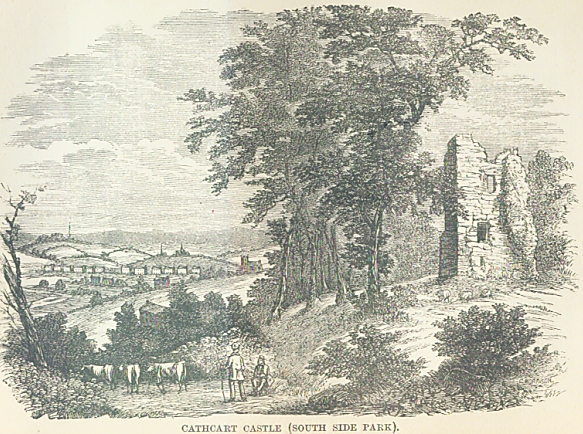
A short distance above the village, on a steep bank
which rises over the Cart, are the ruins of the castle, which we next
proceed to visit. This structure, a massy square tower, must at one period
have possessed great value as a place of security and strength. The date
of its erection and the name of its builder are alike lost in a dark
antiquity. In the days of Wallace and Bruce it was in the possession of an
Alan de Cathcart, who did good service in, the cause of Scottish
independence. From this individual the present Earl of Cathcart is
lineally descended. About the middle of the sixteenth century, the barony
and castle of Cathcart were sold by the then possessor to the Lord of
Sempil, from whose family it was transferred to the Blairs of Boghen. In
1801 it was purchased by the late Earl of Cathcart, whose son, the present
earl, is now its proprietor. On examining the castle, we find it to be one
of those stubborn fragments of the past which seem destined to bid an
enduring defiance alike to the war of the elements and of time. By the
measurement of our stag we find its walls to be not less than ten feet in
solid thickness. It is now roofless and chamberless, with the exception of
a vault, wherein darkness is rendered visible by the light which enters at
a narrow loophole. Here, probably, in "the good old times" when the law of
the land was the caprice of a lordling, the unhappy serfs who happened to
displease their feudal superior were kept secure until it might be found
convenient to dispose of them otherwise. This place has a damp
charnel-house smell, which speedily sends us into the sunshine again. The
crumbling tower is in some parts thickly mantled with ivy, the haunt of
the starling and sparrow, while the swift builds its nest and the
wall-flower waves its golden flowers in the loop-holes and window-places.
From the castle there is a fine view of the vale of the Cart, with the
modern mansion of the family in the foreground, and a perfect wilderness
of foliage around and beyond. There are, indeed, some exquisite snatches
of landscape in this vicinity, and we would recommend the locality
altogether to the special attention of our Glasgow artists, who, like
others, are too apt to run from home in their pursuit of the beautiful.
About a hundred yards or so east from the castle is the
"Court Knowe," where Queen Mary stood at the most critical moment of her
life. A thorn-tree which threw its shadow over her, and was long called by
her name, grew on the spot until the close of the last century, when it
fell into decay through age. An upright slab of stone, with a rude carving
of the Scottish crown, and the letters "M.R. 1568," now mark the spot.
This interesting memento of the beauteous being who in a past age ascended
to its site—a queen with thousands of gallant men at her command—and in
one little hour thereafter descended from it a hapless fugitive, has been
appropriately shaded by a fine clump of trees. We find the speedwell, the
king-cup, and the forget-me-not blooming in beauty on the velvet turf that
had been dewed with the tears of royalty, and the emblematic
-
"Pansy that looks up
Like a thought earth-planted."
It is indeed a lovely and a fitting place to muse on
that fair, ill-fated woman, whose memory is inseparably linked to so many
beauteous scenes, and whose story must ever touch the deepest sympathies
of the pensive heart. The evening sun is bathing the landscape in mellow
radiance while we linger, and the wild birds are singing their vespers as
if misfortune and sorrow had never flung their shadows there; but the
winds are murmuring a plaintive melody among the trembling leaves, and
showering around us the fine gold of the laburnum, which is now becoming
dim, as if nature, entering into our feelings, meant to show the
evanescence of earthly glory. The landscape seen from this station is
extensive and beautiful, including, as is well known, an excellent
prospect of the battle-field of Lang-side. The blue smoke of Cathcart is
seen close at hand curling through the trees; beyond is the church and the
shadowy burying-place; and in the distance the spires of Glasgow, relieved
against the towering Kilpatrick hills.
Descending from our elevation, we cross the Cart by the
old bridge, a structure which bears a considerable resemblance to the Brig
o’ Doon, and on the sides of which the botanist will find several
beautiful though minute species of ferns. We then take our way to New
Cathcart, a neat and tidy-looking little village, which lies about the
third of a mile to the west. It is of modern origin, and possesses but few
features of interest. From thence, along a pleasant country road, we pass
by Millbrae to Langside. This little hamlet, which has been rendered
remarkable by the decisive skirmish which occurred in its vicinity between
the troops of Queen Mary and those of the Regent Murray, on the 18th of
May, 1568, is finely situated nearly on the ridge of a long hill which
lies at a little distance to the south-west of Glasgow. The story of the
battle, with its antecedents and ultimate consequences, is familiar to
every student of Scottish history. Queen Mary on her escape from Lochleven,
immediately, with the assistance of her friends, many of whom were
possessed of great influence, proceeded to organize an army for the
recovery of that power which, while in captivity, she had been compelled
formally to renounce. In a short period she found herself at the head of a
considerable body of troops. With these she was on her march from Hamilton
to Dumbarton, when she found herself intercepted by the vigilant and
energetic Regent, who having heard of her advance, pushed out from Glasgow
with all the forces he could command, and took up a favourable position at
the village of Langside. With greater bravery than prudence Mary’s party
resolved to risk an engagement; and while she proceeded to the position we
have previously described, her troops at once formed themselves into order
of battle on the north side of Clincart Hill, a gentle eminence adjoining
that on which their opponents were drawn up in battle array. Impatient of
delay, the inexperienced infantry of the Queen rushed up the hill to the
attack, but from the unfavourable nature of the ground, and the superior
numbers and discipline of the Regent’s troops, after a brief but
sanguinary struggle, they were repulsed, and by a decisive charge of
cavalry, which was skilfully directed against their flank at a critical
moment, they were involved in inextricable confusion, and ultimately put
to complete rout. Nearly three hundred of the Royalists, it is stated,
fell on the field of battle, while four hundred were made prisoners. The
loss of the Regent was trifling in the extreme. On returning to the city
he caused thanks to be publicly offered to the Deity for a victory
which, on his side, was almost bloodless; and he rewarded the Corporation
of Bakers, who had particularly distinguished themselves by their bravery
on the occasion, by bestowing on them the lands of Partick, where their
mills are now built. Poor Mary, on seeing the overthrow of her friends,
took to flight, and, it is said, scarcely closed an eye until she arrived
at Dundrennan Abbey in Galloway, nearly sixty miles from the fatal scene.
By what route she arrived there we cannot now tell, but several spots in
our vicinity are pointed out by tradition as marking the way she took.
Between Cathcart and Rutherglen is a place called "Mel’s Mire," where it
is said her horse almost stuck fast, in consequence of the muddy nature of
the soil. On the same line, but nearer Rutherglen, is a place called the "Fants,"
it is said from the panting which her steed made while hurrying past. A
little to the east of this, at a place called "Din’s Dykes," two fellows
who were cutting hay lifted their scythes and threatened to take her
captive. Some of her friends coming up, however, compelled the haymakers
to clear the way, when she passed on; and we next hear of her in a
Cambuslang tradition, crossing the Clyde a little below Carmyle, at a
place called the "Thief's Ford." Here we lose sight of her until, weary
and worn, at the close of the day, she is found at Dundrennan, where a
rhyming friend of our’s puts the following words of lamentation into her
lips, which, as appropriate to the occasion, and hitherto unpublished, we
shall present to our readers:—
"Loud roars the wind adown the
shaw,
The drumlie clouds are big wi’ rain,
Fast hameward flees the frichten’d craw,
The sea-bird, screaming, leaves the main;
Sae I, before misfortune’s gale,
A waefu’ wanderer now mann flee—
An exile sad free ll I love,
Despair alone remains with me.
"Thou sun, red sinking down the west,
Oh, haste thee, close the hateful day
With ruin fraught, and stained with gore
Of noblest hearts—my pride and stay.
Triumphant treason’s banner floats
O’er purpled Cartha’s devious way,
Where hearts that heaved yestreen wi hope
Lie cauld sad lifeless in the day.
"O God! how bitter is the cup
Thy chastening hand has filled for me—
How crushing is the weird of wrath
That I, a worm of earth, mann dree!
My country false, my babe estranged,
My name the butt of calumny;
Even hope—the wretch’s friend—takes wing,
Nor dares to mock my agony.
"Vain pomp and grandeur of the world,
How false to me your pleasures seem!
Like drewdrope melting in the sun,
Or bubbles on the mountain stream.
Now, I maun bid farewell to pride,
And I maim stoop—oh, thought of woe!—
This aching, crownless, homeless head,
A suppliant to my direst foe.
"Proud land of hills—my fatherland—
Adieu!—a long, a last adieu!
Despair is whispering to my soul
I ne’er again shall gaze on you.
Oh, when your hapless Mary‘s gone,
May brightest fortune be your fa’ !
Ye’ll haply mourn your wrangs to me,
When I for aye have passed awa’."
But all signs of battle have long been effaced from the
fair brow of Langside; and it is fervently to be hoped that never again
may the soil of our country be stained with the blood of brother fighting
against brother, as on that dark day. The very spirit of peace indeed
seems brooding over the scene as we pass along the pleasant hill. The
farmer is plodding home in the gathering gloaming from the toils of the
day. The soft rustle of the waving grain is making sweet music to the
passing winds, which have been wantoning through the bloom of the bean,
"And bear its fragrant sweets alang."
The lark is leaving the sky, and seeking its mate on
the grassy lea; while the bat comes flickering past, and the bugle of the
"shardborne beetle" is occasionally heard in the thickening air. This walk
is indeed delicious. The prospect is extensive and beautiful. In the
valley beneath, amid richly cultivated fields, the Cart is seen by
glimpses winding its devious way; farther off, and in various directions,
the spires of Glasgow, Rutherglen, and Cambuslang attract the eye of the
spectator; while Cathcart, with its fine church, its picturesque cottages,
and its old castle peeping over the trees, nestles sweetly on the green
slopes below.
The village or hamlet of Langside consists of some
score or so of houses, principally one storeyed cottages, clustering
irregularly amidst patches of garden, and finely screened by fruit and
other trees. Like most other Scottish villages, it seems to have been left
in a great measure to "hing as it grew," and consequently it possesses a
picturesqueness of aspect to which our more regularly constructed modern
towns are utter strangers. The majority of the inhabitants are weavers,
who manage to make ends meet better than the generality of their city
brethren, by the cultivation, during spare hours, of their bits of kail-yard,
the produce of which adds materially to the comfort of their families.
Several of them are famous for the quality of their gooseberries, the
excellence of which during July and August tempts numerous parties from
the neighbouring city. We have not learned that anything beyond the
general tradition regarding the battle, which is common over the country,
has been preserved by the inhabitants of Langside. A neighbouring farmer,
we are informed, has several times discovered old horse-shoes, bits of
bridles, and other relics, while cultivating the fields where the
engagement took place; but beyond these no vestige of "what has been" is
now in existence. [The hill of Langside is in process of being covered by
ornamental cottages and villas. Already the Clincart Knowe is crowned by a
couple of tenements, and even on the very spot where the contest occurred,
a number of houses have been erected. These neat and comfortable looking
domiciles certainly do not harmonize with the associations of the spot;
while a public work, which has just been planted In the basin of the Cart.
still more detracts from the amenity of the picture.]
"All, all Is quiet now, or only heard
Like mellowed murmurs of the distant sea."
A walk of short duration from the field of battle
brings us safely into the artificial day of the lamp-lighted streets.
Three Aikenhead
and Hagthornhill Deeds, 1508-1545
LANGSIDE BATTLEFIELD
MR. WILLIAM GEMMILL, writer, Glasgow, has an
unusually interesting little group of title deeds of lands on the south
side of Glasgow, all originally part of the Aikenhead estate in the
parish of Cathcart. Many reasons make these documents historical.
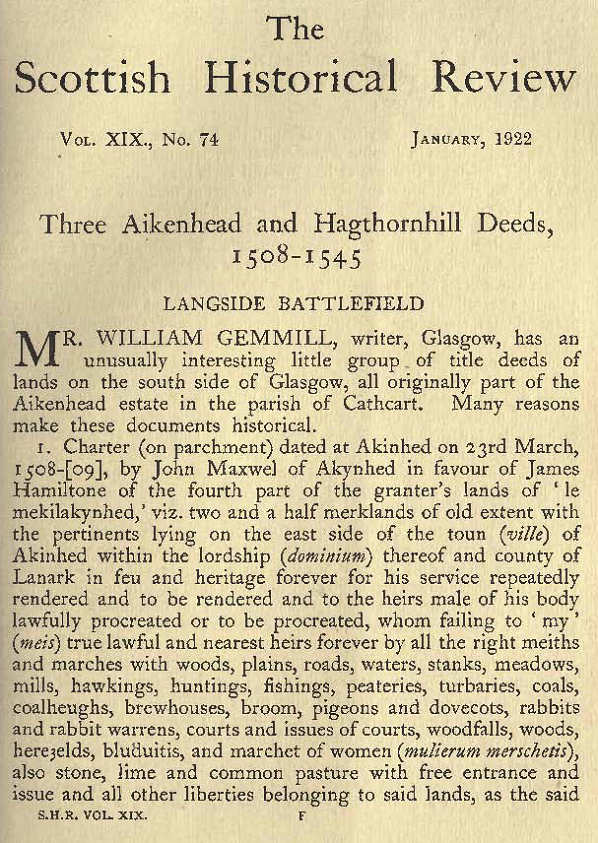
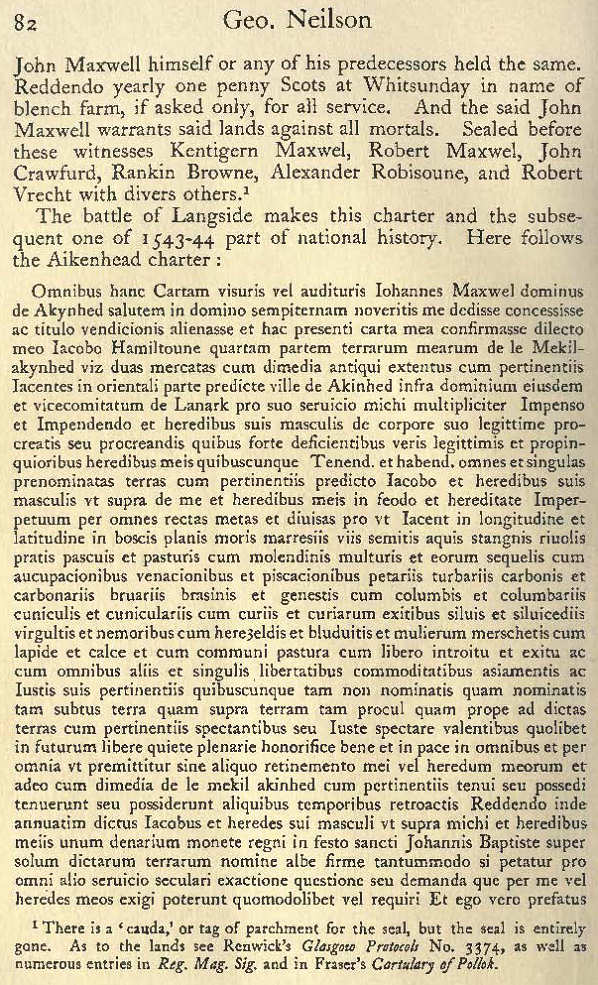
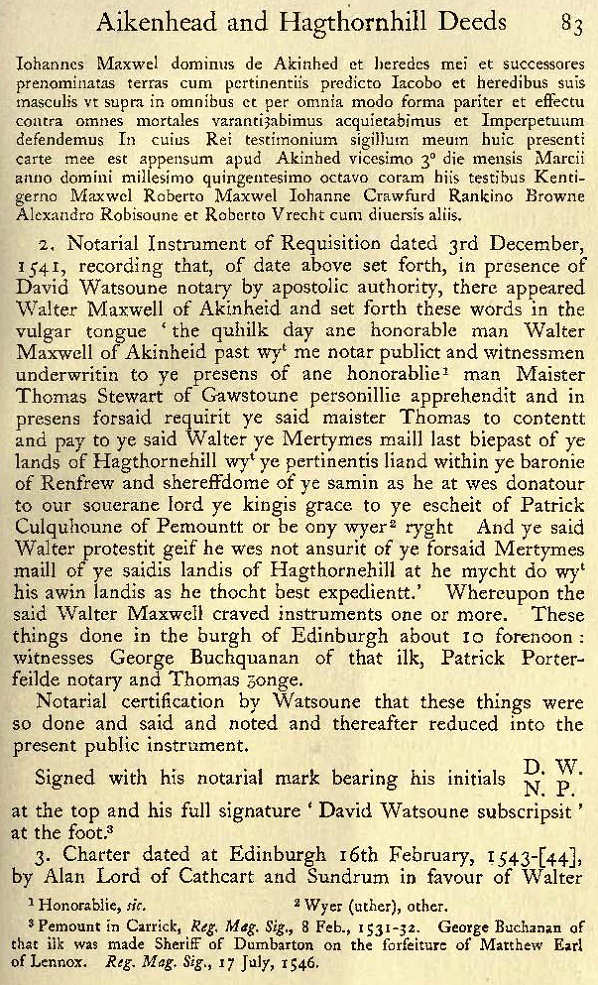
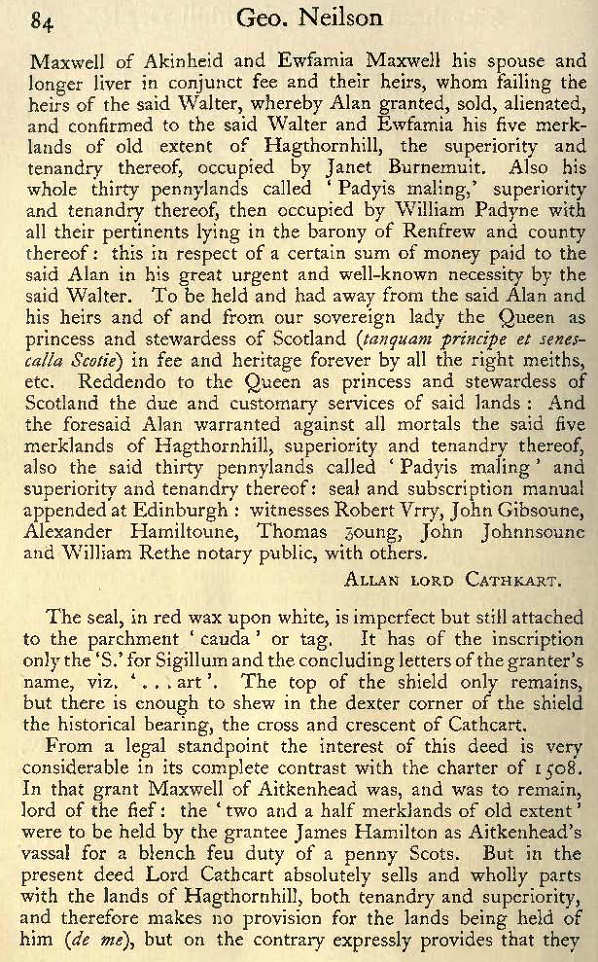
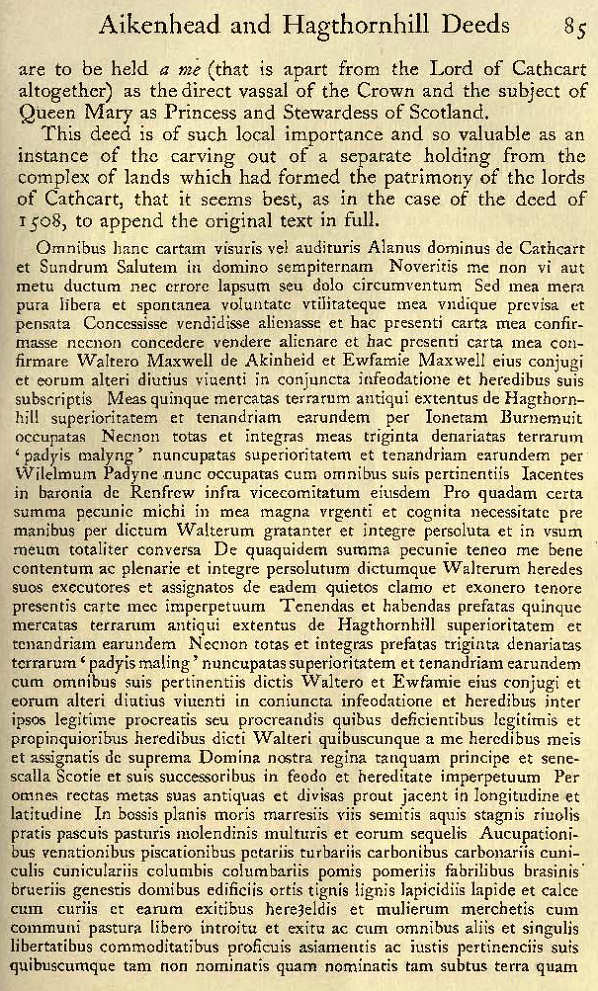
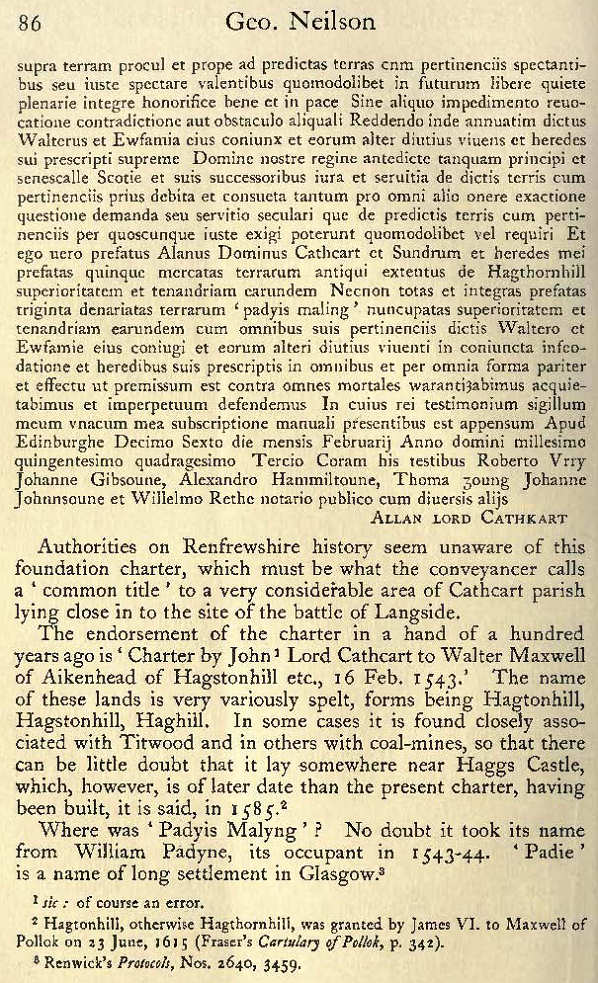
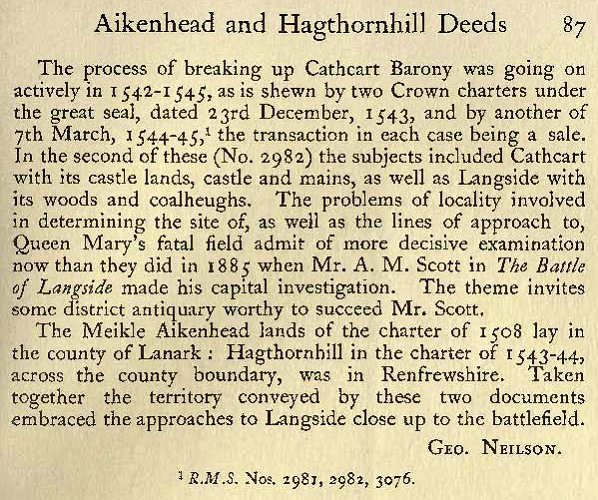 |

